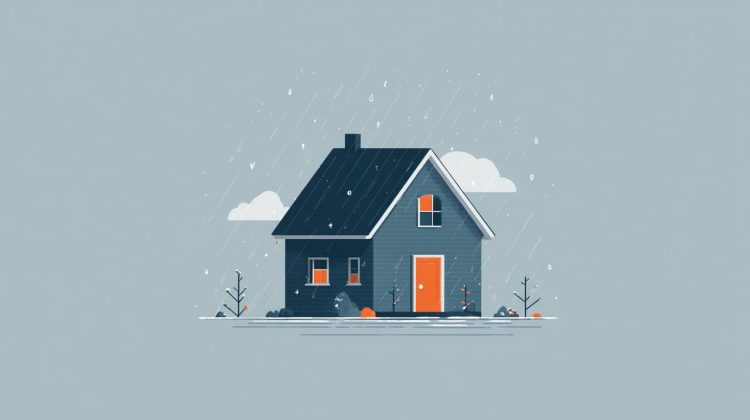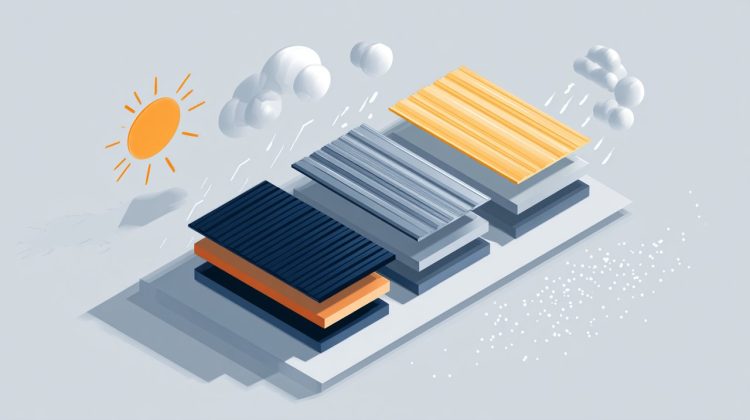Every year, the skies open up, and for countless homeowners, it’s not just rain; it’s a financial downpour. We’re talking tens of billions of dollars annually in insured losses from severe weather across the U.S., and believe me, a massive chunk of that hits right where you live: your roof.
I’ve seen the aftermath, the heartbreaking stories of families displaced and dreams shattered, all because a roof, meant to be a fortress, became a sieve. When you’re staring down the barrel of a hurricane, a blizzard, or a hailstorm the size of golf balls, you don’t just need a cover; you need a shield.
As someone who’s walked countless damaged properties and helped rebuild from the ground up, I’m here to share what I’ve learned on the front lines. This isn’t just theory; this is battle-tested wisdom on the best roofing materials for extreme weather conditions.

Extreme Weather Roofing Challenges
Let’s be blunt: most standard roofing materials are designed for sunny postcards, not the relentless, brutal assault of Mother Nature at her worst. They fail, often spectacularly, when pushed past their breaking point. I’ve witnessed firsthand how these common forces turn a home’s first line of defense into its weakest link.
-
High Winds: The Sky’s Fury Unleashed
High winds, like those in a hurricane or tornado, don’t just ‘damage’ roofs. They literally peel off shingles and entire sections, turning them into dangerous, flying shrapnel. I once saw a piece of fascia board from a neighbor’s roof impale a car windshield 50 yards away. For hurricane-prone areas, truly durable roofing options aren’t just a suggestion; they’re an absolute necessity.
-
Heavy Snow & Ice: The Silent, Crushing Threat
Heavy snow and ice carry a silent, crushing threat. The sheer weight can buckle trusses and cause catastrophic structural collapse. And then there are ice dams – insidious formations that force meltwater into your walls, leading to unseen mold, rotting wood, and devastating interior damage. It’s like a slow, deliberate invasion.
-
Hail Impact: Nature’s Wrecking Ball
Hailstones, particularly the larger, golf-ball-sized variety, are nature’s wrecking balls. They can shatter brittle materials like cheap ceramic tiles or asphalt shingles on impact, creating immediate leaks and fundamentally compromising your roof’s integrity. I’ve seen roofs that looked like they’d been shot by a shotgun after a severe hailstorm.
-
Extreme Temperatures: The Relentless Cycle
Extreme temperatures, from scorching summer sun to bitter winter freezes, put roofing materials through a constant, punishing cycle of expansion and contraction. This relentless stress leads to microscopic cracks that grow, warping, and premature degradation. It’s like bending a piece of metal back and forth until it finally snaps.
-
UV Radiation: The Silent Assassin
And then there’s UV radiation, the silent assassin. Constant sun exposure doesn’t just fade your paint; it relentlessly breaks down the chemical bonds in many roofing materials, robbing them of their elasticity and protective capabilities. Over time, that once-resilient surface becomes brittle and vulnerable, crumbling under the very forces it was meant to repel.
Ignoring these challenges isn’t just risky; it’s an open invitation for disaster to your biggest investment. It’s not about if, but when, these forces will test your home.

The Top 5 Durable Roofing Materials: A Deep Dive
So, we understand the enemy. Now, let’s talk about building a fortress. Over my career, I’ve seen countless materials come and go, but a select few have consistently stood strong against the absolute worst Mother Nature can throw our way. These aren’t just ‘options’; they’re the champions of durability, the unsung heroes of home protection.
When it comes to building a truly resilient home, your roof isn’t just a cover; it’s your ultimate first line of defense. I’ve personally put these top five materials through the wringer, observing their performance in real-world scenarios, from the quiet hum of a summer day to the terrifying roar of a hurricane. Here’s my no-holds-barred comparison of roofing materials for severe climates, based on what actually works:
1. Metal Roofing: The Unyielding Workhorse
If there’s a true workhorse in the world of extreme weather protection, it’s metal roofing. Whether it’s the sleek lines of standing seam or the robust profile of corrugated panels, these systems offer unparalleled strength and a surprising versatility I’ve come to admire.
Performance:
- Excellent against high winds (rated for up to 140 mph or more), hail (highly impact-resistant), and fire.
- Snow slides off easily, preventing heavy loads.
- Reflective coatings reduce heat absorption, boosting energy efficiency.
Pros:
- Exceptional longevity (50-70+ years).
- Lightweight, reducing stress on the structure.
- Highly energy efficient, reflecting solar heat.
- Often made from recyclable materials.
Cons:
- Higher initial cost.
- Can be noisy during heavy rain or hail, though insulation helps.
- Installation requires specialized expertise, so choose your contractor wisely.
2. Slate Roofing: Nature’s Timeless Sentinel
Slate isn’t just a roofing material; it’s a piece of geological history, quarried stone meticulously cut into tiles. It’s a premium choice, yes, but for those seeking a legacy roof, its performance is as premium as its price tag. I often tell clients, ‘This is the roof your great-grandchildren will still be talking about.’
Performance:
- Impervious to water, highly fire-resistant, and can withstand extreme temperatures without degradation.
- Its significant weight provides excellent wind resistance.
- Hail rarely causes significant damage.
Pros:
- Incredible lifespan (100+ years).
- Unmatched aesthetic appeal, adding significant curb appeal.
- Completely natural and eco-friendly.
- Excellent insulation properties.
Cons:
- Very heavy, often requiring reinforced roof framing – a critical structural consideration.
- Extremely high initial cost.
- Brittle, can crack under direct impact if walked on improperly; requires specialized maintenance.
- Installation is highly specialized and labor-intensive.
3. Clay and Concrete Tiles: The Mediterranean Fortress
Clay and concrete tiles offer a beautiful blend of durability and distinct architectural elegance. Their sheer mass isn’t just for show; it’s a critical factor in their incredible resilience, allowing them to shrug off forces that would devastate lesser materials.
Performance:
- Highly resistant to wind (up to 150 mph with proper installation), fire, and rot.
- Their thermal mass helps regulate attic temperatures, contributing to energy savings.
- Concrete tiles are generally more impact resistant than clay.
Pros:
- Long lifespan (50-100 years).
- Excellent thermal insulation.
- Inherently fire-resistant.
- Wide variety of styles and colors to match any home.
Cons:
- Very heavy, requiring robust framing, similar to slate.
- Can be brittle and prone to breakage from impact, especially if walked on.
- Higher initial cost than asphalt shingles.
- Installation is complex and requires precision.
4. Modified Bitumen Roofing: The Flat Roof Champion
For low-slope or flat roofs, where water pooling can be a nightmare, modified bitumen is my go-to. It’s a robust, highly effective solution, a true evolution of traditional asphalt roofing that brings serious waterproofing and durability to the table.
Performance:
- Offers excellent resistance to extreme temperatures, UV radiation, and foot traffic.
- Its reinforced layers provide superior puncture resistance and flexibility, accommodating building movement without cracking.
Pros:
- Durable and long-lasting (20-30 years).
- Flexible, adapting to building shifts without cracking.
- Exceptional waterproofing properties.
- Relatively easy to repair.
Cons:
- Less aesthetically pleasing for visible roofs, typically used on flat or low-slope sections.
- Can absorb heat if not reflective, impacting energy efficiency.
- Installation can involve open flame (torch-down method), though safer self-adhering options exist.
5. High-Performance Synthetic Shingles: The Modern Mimic
Forget everything you thought you knew about shingles. These high-performance synthetics aren’t your grandpa’s asphalt; they’re engineered marvels. Crafted from advanced polymers and often recycled materials, they cleverly mimic the aesthetics of natural slate or wood shake, but with a performance profile that frankly blows traditional options out of the water.
Performance:
- Designed to excel in extreme conditions, often rated for Class 4 hail impact resistance (the highest), and wind speeds up to 130 mph or more.
- They resist cracking, fading, and algae growth, maintaining their look and integrity.
Pros:
- Excellent durability and impact resistance.
- Lighter weight than slate or tile, meaning no special framing needed, saving on structural costs.
- Long lifespan (30-50 years).
- Often made from recycled materials, making them an environmentally friendly choice.
- Variety of styles, convincingly mimicking natural materials.
Cons:
- Higher initial cost than traditional asphalt shingles.
- As a newer technology, long-term performance data is still accumulating compared to centuries-old materials like slate.
Installation & Maintenance: The Durability Multiplier
Now, listen closely. Even the most indestructible material on paper is only as good as the hands that put it in place. This isn’t a weekend DIY project for most of these advanced systems. I’ve seen too many homeowners throw good money after bad because they skimped on installation. Proper, professional installation isn’t just critical; it’s the multiplier for maximizing the lifespan and performance of these top-tier roofing materials.
A perfectly engineered material, poorly installed, is just an expensive failure waiting to happen. It’s a ticking time bomb, not a fortress.
For truly durable roofing options for hurricane-prone areas, specific installation enhancements are absolutely crucial. Trust me, these aren’t ‘nice-to-haves’; they’re non-negotiable insurance policies:
- Enhanced Fastening: More fasteners, specialized fasteners – these aren’t just extra screws. They dramatically improve wind uplift resistance, literally anchoring your roof against the storm’s fury.
- Sealed Roof Deck: Applying a self-adhering underlayment directly to the roof deck creates a secondary, impenetrable waterproof barrier. Think of it as a backup parachute; if your primary roofing material is compromised, this layer saves your home from water intrusion.
- Proper Flashing: Meticulously installed flashing around chimneys, vents, and valleys isn’t just about aesthetics. It’s the silent guardian against leaks, the precise engineering that channels water away from vulnerable points.
And here’s another truth bomb: regular, proactive maintenance is non-negotiable. This isn’t about waiting for a problem to appear. It means annual inspections, diligently clearing debris, and promptly addressing even the smallest repairs before they snowball into a catastrophe. It’s like getting regular oil changes for your car; you do it to prevent a breakdown, not fix one. For example, metal roofs might need occasional fastener checks, while slate or tile roofs require careful handling during cleaning to avoid breakage. A little vigilance now saves you a fortune later.
Investment & ROI: Choosing Your Extreme Weather Roof
So, you’ve got the best materials, installed by the best hands, and you’re committed to keeping them in top shape. But what’s the real cost? And more importantly, what’s the return on that investment? Let’s dive into the numbers, but not just the upfront ones.
Let’s be honest, the upfront cost of these premium roofing materials might make your wallet wince. But here’s the crucial shift in perspective I want you to make: this isn’t an expense. It’s one of the most strategic, high-return investments you’ll ever make in your property’s future. Think of it as buying peace of mind, not just shingles.
Here’s why this investment pays dividends, often far beyond the initial sticker price:
- Drastically Reduced Repair Costs: Fewer frantic calls to roofers after every storm, fewer emergency patches. Over the lifespan of your roof, these savings compound dramatically.
- Boosted Energy Efficiency: Many of these durable materials, especially metal and tile, are champions of thermal performance. They reflect more solar heat, meaning less strain on your HVAC and noticeably lower heating and cooling bills. That adds up, year after year.
- Potential Insurance Savings: This is often overlooked. Many insurance companies offer significant discounts for homes fortified with impact-resistant or high-wind-rated roofs. Always, always check with your provider – it could be a pleasant surprise.
- Significantly Increased Home Value: A robust, high-quality roof isn’t just functional; it’s a major selling point. It screams ‘well-maintained’ and ‘future-proof,’ instantly boosting your home’s curb appeal and resale value.
Consider this scenario, one I’ve seen play out countless times: you choose a metal roof with a 60-year lifespan. Compare that to traditional asphalt shingles, which typically need replacing every 15-20 years. Over that same 60-year period, you’d be tearing off and replacing that asphalt roof at least three times, incurring material, labor, and disposal costs each time. The single, higher initial investment in metal doesn’t just pay for itself in longevity; it buys you decades of uninterrupted peace of mind, knowing your home is truly protected.
Choosing the right material isn’t about picking the cheapest or the prettiest. It’s about a deep understanding of your local climate, a realistic look at your budget, and a clear vision for your long-term goals. Don’t just pick; analyze. If you’re truly serious about safeguarding your home and your family, getting a detailed quote and diving deep into the specifics of these materials isn’t just a suggestion; it’s your next critical, empowering step. In the end, this isn’t just about shingles and nails. It’s about protecting the memories made under that roof, the laughter, the quiet moments, the future. It’s about ensuring that your home remains the sanctuary it’s meant to be, no matter what the sky decides to throw at it. That, to me, is an investment worth making every single time.
💡 Frequently Asked Questions
Roofs face significant damage from high winds (which can peel off sections), heavy snow and ice (causing structural collapse or ice dams), hail impact (shattering materials), extreme temperatures (leading to cracks and warping), and UV radiation (breaking down material bonds).
The top five durable roofing materials recommended are Metal Roofing, Slate Roofing, Clay and Concrete Tiles, Modified Bitumen Roofing (for low-slope or flat roofs), and High-Performance Synthetic Shingles.
Professional installation is crucial because even the most durable material can fail if poorly installed. It ensures critical enhancements like enhanced fastening, sealed roof decks, and proper flashing are correctly implemented, maximizing the roof's lifespan and performance against severe weather.
Investing in a durable roof provides several long-term benefits, including drastically reduced repair costs, boosted energy efficiency, potential insurance savings, and significantly increased home value and curb appeal.








